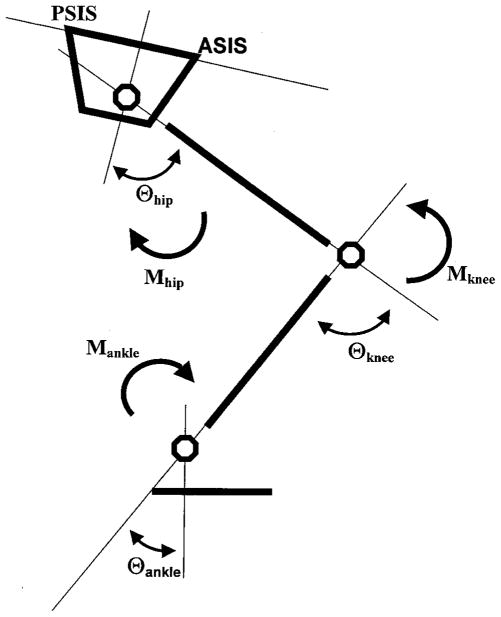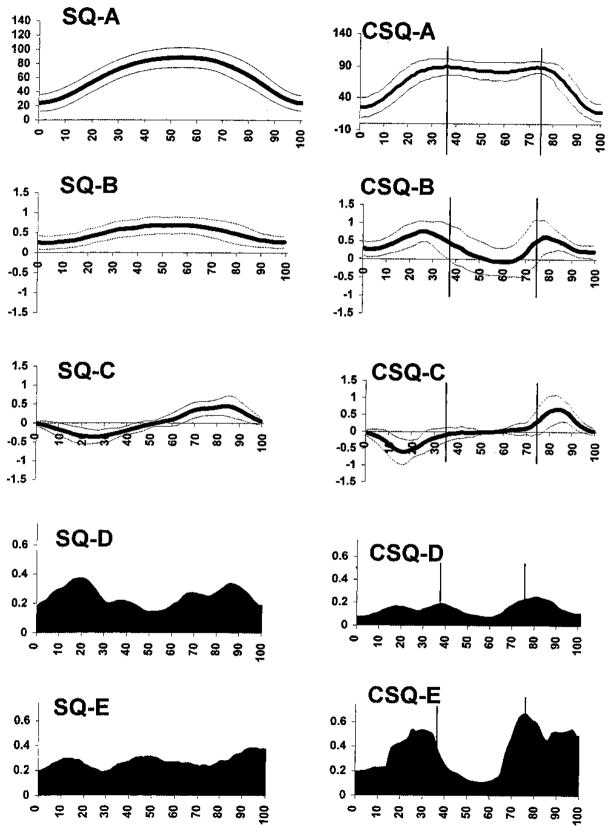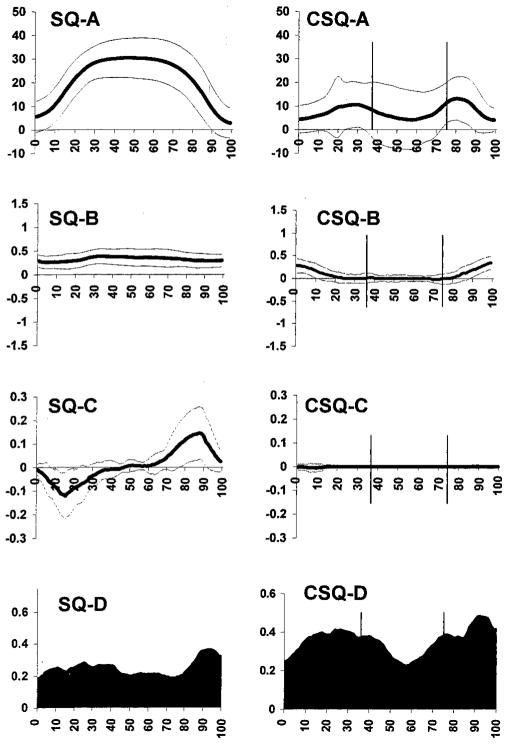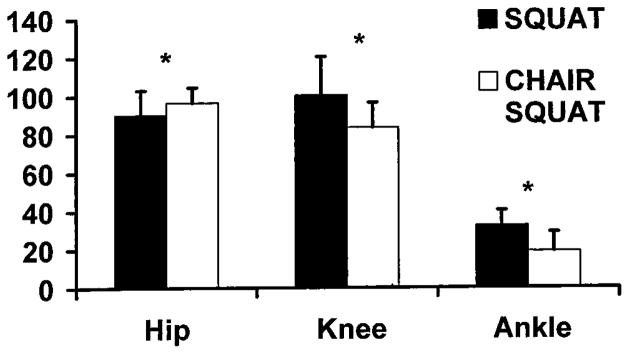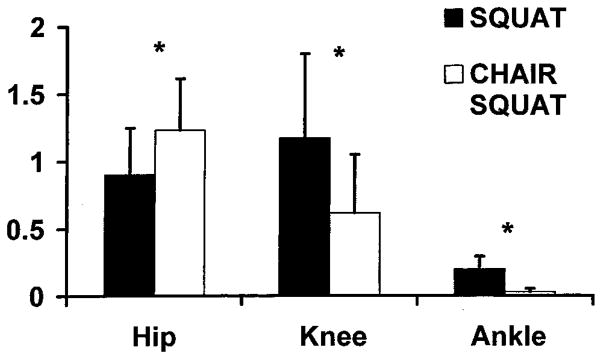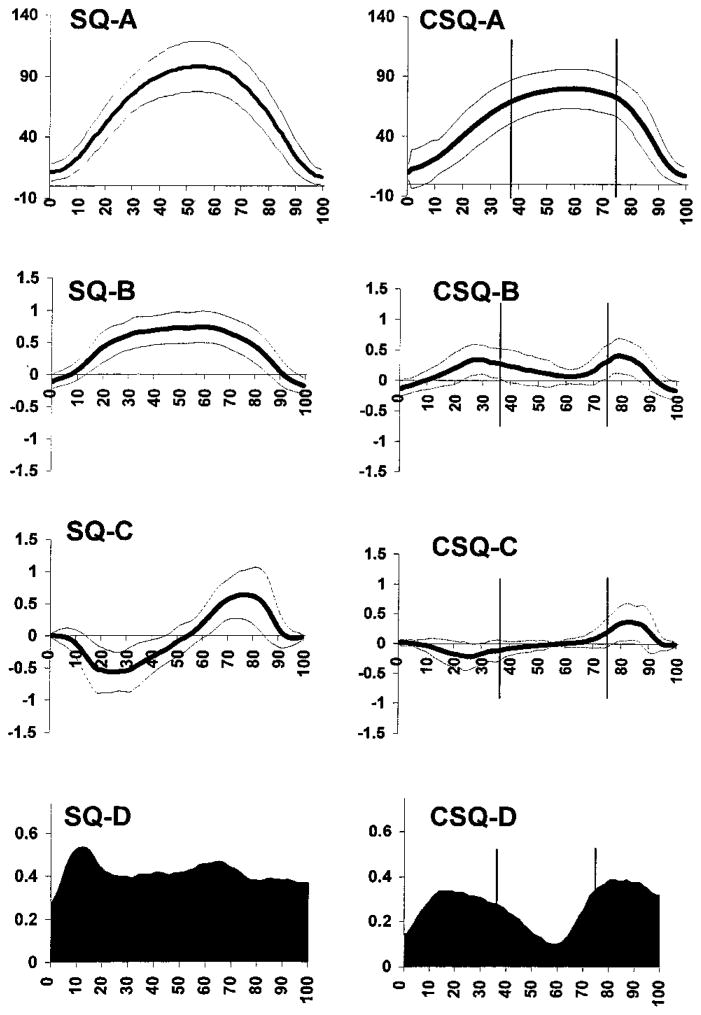Abstract
Purpose
Squatting activities may be used, within exercise programs, to preserve physical function in older adults. This study characterized the lower-extremity peak joint angles, peak moments, powers, work, impulse, and muscle recruitment patterns (electromyographic; EMG) associated with two types of squatting activities in elders.
Methods
Twenty-two healthy, older adults (ages 70–85) performed three trials each of: 1) a squat to a self-selected depth (normal squat; SQ) and 2) a squat onto a chair with a standardized height of 43.8 cm (chair squat; CSQ). Descending and ascending phase joint kinematics and kinetics were obtained using a motion analysis system and inverse dynamics techniques. Results were averaged across the three trials. A 2 × 2 (activity × phase) ANOVA with repeated measures was used to examine the biomechanical differences among the two activities and phases. EMG temporal characteristics were qualitatively examined.
Results
CSQ generated greater hip flexion angles, peak moments, power, and work, whereas SQ generated greater knee and ankle flexion angles, peak moments, power, and work. SQ generated a greater knee extensor impulse, a greater plantar flexor impulse and a greater total support impulse. The EMG temporal patterns were consistent with the kinetic data.
Conclusions
The results suggest that, with older adults, CSQ places greater demand on the hip extensors, whereas SQ places greater demand on the knee extensors and ankle plantar flexors. Clinicians may use these discriminate findings to more effectively target specific lower-extremity muscle groups when prescribing exercise for older adults.
Keywords: AGING, BIOMECHANICS, JOINT MOMENT, JOINT POWER, EMG, CHAIR SQUAT, BOX SQUAT
Resistance exercise prescription is a diverse science used to improve sport performance, rehabilitate injury, and preserve functional independence in older adults. Despite its branching applicability, all resistance exercise prescriptions require a fundamental analysis, termed needs analysis. Needs analysis is the process whereby clinicians, coaches, and rehabilitation specialists analyze the biomechanical requirements of an activity to select resistance exercises with similar motor recruitment patterns. Thus, appropriate resistance exercise prescription requires an analysis of both the activity to be improved, restored, or preserved and the exercises that may be used in these endeavors.
The preservation of physical independence is a growing concern within our society, receiving attention from geriatric clinicians, educators, researchers, and exercise specialists. Walking, sitting and rising from a chair, and ascending and descending stairs are important determinants of independence; consequently, researchers are using biomechanical analyses to better characterize these activities. Gait has received comprehensive biomechanical evaluation (30), and although not as consolidated, there is considerable biomechanical information on ascending and descending stairs (7), and rising from a chair (22). The same level of analysis, however, has not been conducted on the exercises that are used to improve, maintain, and restore these movements.
The squat is a functional, multiple-joint exercise that has received considerable biomechanical evaluation. Investigations have examined the kinematics (20), kinetics (21), and muscle recruitment patterns (17) of the squat at various joints (13) for different stances and loads (5); however, investigations have not characterized these parameters in elders using variations of the exercise.
One such variation of the squat that may be particularly applicable for older adults is the box or chair squat. The chair squat is performed by squatting (i.e., lowering the body’s center of mass by flexing the hip and knee joints, and dorsiflexing the ankle joints) onto a stable surface such as a box, bench, or chair, and then rising to a standing position. Both the squat (SQ) and chair squat (CSQ) can be performed in the home without specialized equipment, without supervision, and using varying resistance (e.g., elder participants can use their BW without additional resistance or wear a resistance-adjustable weighted vest). Further, although both activities can be performed using self-spotting techniques (e.g., participants can support themselves at a countertop while performing the activities), the CSQ may be especially appropriate for older adults because: 1) the exercise mimics rising from and sitting onto a chair; thus, it may provide a high degree of exercise transference to this “activity of daily living”; and 2) squatting onto a stable surface increases the safety of the exercise by providing a seat in the event a repetition cannot be completed (e.g., if the participant becomes fatigued or loses balance).
Both SQ and CSQ activities require simultaneous coordination of the hip, knee, and ankle musculature, and involve alternating concentric and eccentric contractions of these muscle groups. Despite these similarities, however, fundamental differences in the movement patterns of these two exercises (e.g., sitting during CSQ) are likely to invoke differences in the kinematics and kinetics associated with these activities.
The purpose of this investigation was to compare and contrast the kinematics and kinetics associated with two squatting exercises within the same healthy, elder participant sample. We hypothesized that differences in our outcome measures, (hip, knee, and ankle peak joint flexion angles, peak extensor moments, joint power, work, and impulse) would exist between the two exercise movements. This analysis may be used to generate biomechanical profiles of the exercises that may be used by physicians, therapists, and exercise specialists when designing safe and efficient activity programs for elders.
METHODS
Participants
Nine male and 13 female, healthy older adult participants (74.5 ± 4.39 yr) were recruited from the greater Los Angeles area. The average height of the participants was 1.64 ± 0.13 m and the average mass 67.93 ± 15.05 kg. The participants can be described as an independently mobile, healthy, and predominantly Caucasian group of older adults. Potential subjects were screened, using: 1) a self-administered medical history form; 2) a previously published physical activity questionnaire, Advanced Activities of Daily Living Hierarchical Exercise Scale (23); and 3) bone scans of their lumbar spine and dominant hip joint (dual-energy x-ray absorptiometry; Hologic QDR1500, Waltham, MA). To increase the applicability of the results to a large number of older adults, only subjects who were not frequent exercisers were included in the study. Nonfrequent exercises were defined as people who did not participate in active sports (e.g., aerobics, jogging, and tennis) and who did not walk more than a mile, without resting, three or more times per week (23). Potential subjects were also excluded for the following medical conditions: 1) neurological diseases such as stroke, polio, Parkinson’s disease, dementia, or uncontrolled seizures; 2) musculoskeletal disorders such as osteoporosis (T-score < −2.5), joint arthroplasty, current injury, current pain in lower extremities or back, rheumatoid arthritis, polymyalgia rheumatica, balance disturbance, or the need for an assistive device; and 3) cardiovascular disorders such as known angina or coronary heart disease, congestive heart failure, systolic blood pressure greater than 160 mm Hg, or diastolic blood pressure greater than 95 mm Hg. The study protocol was approved by the Health Sciences Institutional Review Board of University of Southern California, and all subjects provided their written consent to participate.
Instrumentation
Fourteen reflective markers (2.5-cm spheres) were placed bilaterally over the following anatomical landmarks: heels, second and fifth metatarsal heads, lateral malleoli, lateral epicondyles, anterior superior iliac spines, and posterior superior iliac spines. Four 5-cm wands with markers were also taped to the lateral thighs and tibiae. Lower-extremity kinematic data were collected using a six-camera motion analysis system at 60 Hz (Vicon 370, Oxford Metrics, Oxford, UK). Ground reaction forces (GRF) were recorded from force platforms at 1200 Hz (model no. OR6-6-1, AMTI, Watertown, MA). Hip, knee, and ankle kinematics were determined using the methods described by Kadaba et al. (19) and Davis et al. (9) (Fig. 1). Joint kinetics were determined using methods described by Kadaba et al. (18) using published anthropometric data (29). Data processing software, Workstation (Oxford Metrics) and Data-pac 2000 (RUN Technologies Co., Laguna Hills, CA) were used for all calculations.
FIGURE 1.
Free-body diagram illustrating the internal (muscular) moments (M) and joint angles (θ) for the ankle, knee, and hip. Directional arrows represent positive joint moments for hip extension, knee extension, and ankle plantar flexion. Joint angles are measured in degrees with increasing joint angles representing greater hip flexion, knee flexion, and ankle dorsiflexion.
Surface electromyographic (EMG) signals of the lower gluteus maximus, hamstrings, vastus lateralis, and gastrocnemius muscles were collected at 1200 Hz using active surface electrodes (B and L Technologies, Irvine, CA). Standard procedures, including preparation of the skin and electrode placement, were employed (8). The obtained EMG signals were amplified (×1000), notch filtered at 60 Hz, and band-pass filtered at 20–500 Hz. A root mean square smoothing algorithm (10) with a 75-ms constant window was used to smooth the EMG data. EMG processing and smoothing were performed using DATAPAC 2000 (RUN Technologies Co.).
Exercise protocol
Research associates instructed the participants in the performance of the SQ (Fig. 2) and CSQ (Fig. 3) activities during their first laboratory visit. During the CSQ, participants were instructed to sit back onto the chair, pause briefly, and then rise. All participants were able to perform this activity without difficulty. The participants then practiced the squatting activities at home until their next laboratory visit, 1–2 wk later. During their next laboratory visit, participants were instrumented for biomechanical analysis. They performed three trials of each of the SQ and the CSQ activities, in random order, at a self-selected pace, during a single data collection session. Data were collected on the dominant leg—the leg the participant used to kick a ball. During data collection, a safety bar was also provided to assist participants if they lost their balance; they were instructed, however, not to use the bar to aid their movement.
FIGURE 2.
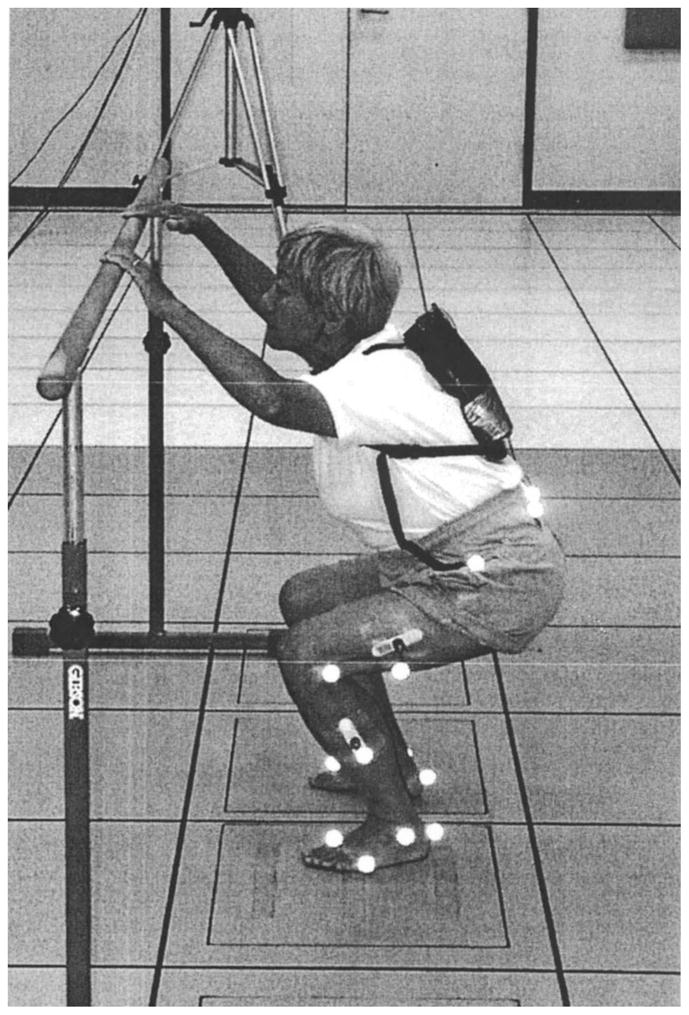
The squat exercise, performed while the participant is instrumented for biomechanical analysis.
FIGURE 3.
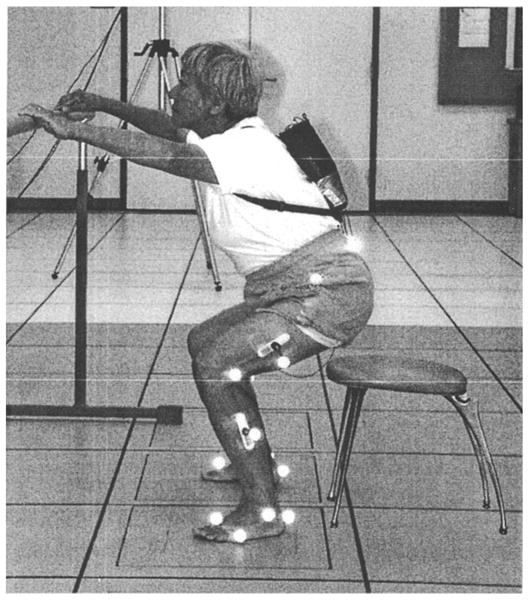
The chair squat exercise, performed while the participant is instrumented for biomechanical analysis.
Data and statistical analysis
The average values of the peak ankle, knee, and hip sagittal-plane flexion angles, extensor moments, total extensor impulse, joint powers, and total work obtained over the three trials were used for statistical analysis. Hip moments in the coronal plane were also quantified. The extensor moments and powers were further divided into descending and ascending phases based upon the maximum knee flexion angle obtained during each trial. Work was calculated as the integrated amplitude of the power curve for each phase of the movement. The total work was calculated as the sum of the absolute value of the negative work (descending phase) and positive work (ascending phase) (27). The extensor impulse was calculated as the integrated amplitude of the extensor moment curve (11). A support angular impulse, or area under the support moment curve (28), was calculated as the sum of the hip, knee, and ankle angular impulses. All statistical procedures were conducted using SPSS software version 10.0 (SPSS, Chicago, IL). Data, averaged over the three trials, were examined for outliers and subjects with data values greater than three times the interquartile range (25–75%) above or below the 75th and 25th percentile, respectively, for any variable, were removed from further statistical analysis. Based upon these “outlier” criteria, two participants’ data were removed from further analyses. Thus, data from a total of 20 subjects were used for the kinetic and kinematic analyses. Additionally, because of equipment difficulties, EMG data could not be collected from four subjects; thus, data from a total of 16 subjects were used for the EMG analysis. Although all statistical analyses were based upon individual kinematic and kinetic data, ensemble average joint excursion, moment, power, and EMG curves were produced in order to qualitatively examine the mean angle, moment, power, and muscle recruitment patterns generated during the squatting activities (Figs. 4–6). For this qualitative examination, the data were normalized so that 100% of the movement occurred when the subjects returned to the starting position.
FIGURE 4.
Ensemble average kinetic and EMG records for the hip during the squat SQ (left side) and chair squat CSQ (right side) normalized to 100% of the movement cycle. A, hip flexion angle in degrees; B, sagittal plane moments in N·m·kg−1; C, power in W·kg−1; D, EMG activity of the lower gluteus maximus normalized to maximum activity during the squat; E, EMG activity of the hamstrings muscle group normalized to maximum activity during the squat. Vertical labels represent the initiation and termination of chair contact during CSQ.
FIGURE 6.
Ensemble average kinetic and EMG records for the ankle during the squat SQ (left side) and chair squat CSQ (right side) normalized to 100% of the movement cycle. A, ankle dorsiflexion angles in degrees; B, sagittal plane moments in N·m·kg−1; C, power in W·kg−1; D, EMG activity of the gastrocnemius muscle normalized to maximum activity during the squat. Vertical labels represent the initiation and termination of chair contact during CSQ.
Two-factor ANOVA (exercise × phase) with repeated measures were conducted to assess the differences in the mean values of our outcome measures, peak extensor moments, and peak joint powers between the two squatting conditions and phases. Post hoc, paired t-tests assessing the difference between squatting types across the ascending and descending phases were conducted when a statistically significant interaction effect was identified with the omnibus test. Paired t-tests were also used to assess the differences in peak joint flexion angles, total work, and extensor impulse, between the two squatting activities at each joint. Ensemble average EMG temporal characteristics were qualitatively assessed.
RESULTS
Joint angular excursion
Ensemble average joint excursion curves were produced in order to examine the mean flexion angle patterns generated during the squatting activities (Figs. 4A–6A). The maximum hip flexion angle obtained during CSQ was 7.2% greater than the angle obtained during SQ (P = 0.03) (Fig. 7). Conversely, the maximum knee flexion and ankle dorsiflexion angles obtained during SQ were 20.4% (P = 0.005) and 70.7% (P < 0.001) greater than those obtained during CSQ.
FIGURE 7.
Peak hip flexion, knee flexion, and ankle dorsiflexion angles in degrees. Values are mean ± SD. *Denotes a statistically significant difference between the squat and chair squat.
Joint moments
Ensemble average joint moment curves were produced in order to examine the mean moment patterns generated during the squatting activities (Figs. 4B–6B). During SQ, a single peak moment was observed at the hip, knee, and ankle, at approximately 55% of the duration of the movement cycle. Conversely, CSQ generated biphasic extensor moments at the hip and knee that peaked at approximately 28% of the movement cycle, declined to zero during contact with the chair (between 37 and 74% of the movement), and then peaked again at 80% of the movement cycle. During CSQ, the plantar flexor moment peaked at the beginning of the movement, decreased to approximately zero by 25% of the movement cycle, remained so throughout contact with the chair, and then increased again between 80 and 100% of the movement.
The ANOVA test identified a statistically significant interaction among the peak hip extensor moments produced across squatting conditions and movement phases (P = 0.046). Post hoc analysis revealed that the average peak hip extensor moment generated during CSQ was 28.8% (P < 0.001) greater than the peak moment generated with SQ during the descending phase and 35.1% (P < 0.001) greater than the peak moment generated with SQ during the ascending phase (Table 1). The average peak hip extensor moment generated with CSQ during the ascending phase was 6.4% greater than that generated during the descending phase (P = 0.026). With SQ, however, the peak hip extensor moments were not statistically significantly different between phases. Average peak coronal plane hip moments did not differ between squatting conditions and movement phases.
TABLE 1.
Average peak net extensor and plantar flexor moments (N·m·kg−1) for the hip, knee, and ankle.
| Joint | Squat | Chair Squat |
|---|---|---|
| Sagittal plane | ||
| Hip moment | ||
| Descending | 0.73 ± 0.21 | 0.94 ± 0.24* |
| Ascending | 0.74 ± 0.22 | 1.00 ± 0.27*# |
| Knee moment | ||
| Descending | 0.78 ± 0.24 | 0.52 ± 0.23* |
| Ascending | 0.79 ± 0.25 | 0.61 ± 0.23*# |
| Ankle moment | ||
| Descending | 0.48 ± 0.14 | 0.32 ± 0.12* |
| Ascending | 0.44 ± 0.15# | 0.39 ± 0.12 |
| Coronal plane | ||
| Hip moment | ||
| Eccentric | 0.13 ± 0.12 | 0.13 ± 0.11 |
| Concentric | 0.13 ± 0.10 | 0.16 ± 0.13 |
Values are mean ± SD.
Statistically significant difference between squat and chair squat (P < 0.05).
Statistically significant difference between ascending and descending phases of the activity (P < 0.05).
A statistically significant interaction was also identified among the peak knee extensor moments produced across squatting conditions and movement phases (P = 0.005). Post hoc analysis revealed that the average peak knee extensor moment produced with SQ was 50% greater than that produced with CSQ during the descending phase (P < 0.001) but only 29.5% greater during the ascending phase (P = 0.001). The average peak knee extensor moment for the ascending phase was 17.3% greater than the descending phase (P = 0.001) during CSQ but did not differ between phases for SQ.
The omnibus test identified a statistically significant interaction among the peak plantar flexor moments produced across squatting conditions and movement phases (P = 0.009). Post hoc analysis revealed that the average peak plantar flexor moment produced with SQ was 50% greater than with CSQ during the descending phase (P = 0.001); however, differences were not observed during the ascending phase. The average peak plantar flexor moment produced with SQ during descent was 9.1% greater than during ascent (P = 0.026); however, the peak moments were not statistically different between phases with CSQ.
Peak power
Ensemble average joint power curves were produced in order to examine the mean power patterns generated during the squatting activities (Figs. 4C–6C). Joint power was absorbed during the descending phase (negative) and generated during the ascending phase of both activities. During CSQ, there was a time period, during the mid-range of the movement, where the net joint power at the hip and knee approached zero. This is the time period where subjects were “sitting” on the chair. At the ankle, however, the net joint power was close to zero throughout the duration of the CSQ movement.
A main effect difference between squatting conditions (P < 0.001) and movement phases (P = 0.002) was identified for the average peak hip power (Table 2). Post hoc analysis revealed that the average peak hip power generated with CSQ was 52.9% greater than with SQ (P < 0.001). Further, the average peak hip power generated during ascent was 18.5% greater than the power absorbed during descent (P = 0.002).
TABLE 2.
Average peak sagittal plane extensor and plantar flexor power (W·kg−1) for the hip, knee, and ankle.
| Joint | Squat | Chair Squat |
|---|---|---|
| Hip power | ||
| Descending | 0.52 ± 0.21 | 0.78 ± 0.29* |
| Ascending | 0.60 ± 0.25 | 0.93 ± 0.32*# |
| Knee power | ||
| Descending | 0.77 ± 0.36 | 0.39 ± 0.05* |
| Ascending | 0.82 ± 0.40 | 0.63 ± 0.28*# |
| Ankle power | ||
| Descending | 0.18 ± 0.08 | 0.04 ± 0.09* |
| Ascending | 0.20 ± 0.11 | 0.08 ± 0.07* |
Values are mean ± SD.
Statistically significant difference between squat and chair squat (P < 0.05).
Statistically significant difference between ascending and descending phases of the activity (P < 0.05).
A statistically significant interaction was identified among the joint powers across squatting conditions and movement phases at the knee (P = 0.005). Post hoc analysis revealed that the average peak knee power generated during SQ was 97.4% greater than CSQ during the descending phase (P < 0.001) but only 30.2% greater than CSQ during the ascending phase (P = 0.049). Moreover, during CSQ, peak knee power generated during the ascending phase was 61.5% greater than the power generated during the descending phase (P < 0.001). With SQ, however, the peak knee power was not statistically significantly different between phases. A main effect difference between squatting conditions was identified for the average peak ankle power—SQ generated 213% more ankle power than CSQ (P < 0.001). No phase differences, at the ankle, were identified for either SQ or CSQ.
Extensor impulse
The total support impulse generated during SQ was 31.5% greater than the total impulse generated during CSQ (P = 0.006). The extensor impulse at the hip did not differ between SQ and CSQ (P = 0.5); however, the knee extensor impulse was 52.0% greater during SQ than during CSQ (P = 0.002), and the ankle plantar flexor impulse was 160.0% greater during SQ than during CSQ (P < 0.001) (Table 3).
TABLE 3.
Average total support impulse and angular impulsea (N·m·s·kg−1) for the hip, knee, and ankle.
| Joint | Squat | Chair Squat |
|---|---|---|
| Hip | ||
| Angular impulse | 1.93 ± 0.89 | 2.08 ± .92 |
| % of total support impulse | 41.1 ± 10.9 | 58.1 ± 11.4 |
| Knee | ||
| Angular impulse | 1.58 ± 0.76 | 1.05 ± 0.85* |
| % of total support impulse | 33.7 ± 11.1 | 29.1 ± 13.6 |
| Ankle | ||
| Angular impulse | 1.13 ± 0.54 | 0.48 ± 0.20* |
| % of total support impulse | 26.5 ± 9.5 | 13.1 ± 7.0 |
| Total support impulseb | 4.74 ± 1.48 | 3.61 ± 1.47* |
Values are mean ± SD.
Joint angular impulses were calculated as the sum of the integrated amplitudes of the extensor moment curves [N·m·s·kg−1], for each activity.
Total support impulse was calculated as the sum of the individual joint angular impulses.
Statistically significant difference between squat and chair squat (P < 0.01).
Total work
The total work performed during CSQ at the hip was 25.4% greater than the work performed during SQ (P = 0.001) (Fig. 8). Conversely, the total knee and ankle work performed during SQ was 51.2% (P < 0.001) and 159.6% (P < 0.001) greater than the work performed during CSQ, respectively.
FIGURE 8.
Total extensor work (J·kg−1) generated at the hip, knee, and ankle during the squatting activities. Values are mean ± SD. *Denotes a statistically significant difference between the squat and chair squat.
Electromyography
Visual inspection of the curves suggests that CSQ generated biphasic peaks in muscle activity for hamstrings, vastus lateralis, and gastrocnemius muscle groups (Figs. 4, D and E; 5D; and 6D). Conversely, only the lower gluteus demonstrated a biphasic activity pattern during SQ. Moreover, it appears that the peak activity of the lower gluteus, hamstrings, and vastus lateralis was temporally associated with the peak joint moments and powers during CSQ; however, SQ temporal patterns appeared to be less consistent.
FIGURE 5.
Ensemble average kinetic and EMG records for the knee during the squat SQ (left side) and chair squat CSQ (right side) normalized to 100% of the movement cycle. A, knee flexion angles in degrees; B, sagittal plane moments in N·m·kg−1; C, power in W·kg−1; D, EMG activity of the vastus lateralis muscle normalized to maximum activity during the squat. Vertical labels represent the initiation and termination of chair contact during CSQ.
DISCUSSION
This study identifies two distinct kinetic profiles associated with the performance of SQ and CSQ activities in older men and women. The SQ activity primarily targeted the knee extensors and ankle plantar flexors, as evidenced by the relatively large peak moments, powers, impulses, and total work produced at the ankle and knee joints. The CSQ activity primarily targeted the hip joint, generating comparatively greater hip extensor kinetics.
Prospective studies indicate that resistance exercise programs produce substantial muscular strengthening and increased physical performance in older men and women (6,16). Wide-scale implementation of resistance-training programs for older adults, however, has been difficult because traditional programs require specialized equipment, close supervision, and in most cases, participant travel. To overcome these barriers to exercise in older people, Barry and Eathorne (3) have suggested that exercise should be low to moderate intensity, fun, interesting, convenient, effective, and safe. SQ and CSQ activities appear to possess these characteristics because: 1) they can be performed in the home without specialized equipment; 2) they can be performed without supervision; 3) they can be performed using varying resistance (e.g., participants can use their BW or wear a weighted vest); and 4) they can be performed relatively safely (e.g., participants can use self-spotting techniques at a countertop while performing the activities). Moreover, SQ and CSQ activities may be especially relevant exercises for older adults because they require simultaneous coordination of hip, knee, and ankle musculature, and CSQ mimics sit-to-stand and stand-to-sit transfer activities.
Despite their common applicability and general attributes, kinematic and kinetic differences between SQ and CSQ activities can be used by clinicians to specifically target intended muscle groups in older adults. For example, in elders with diagnosed plantar flexor and/or knee extensor weakness, the SQ activity is likely to be more effective than the CSQ activity at reducing strength deficits in these muscle groups. Conversely, the CSQ exercise is likely to be more beneficial for elders exhibiting hip extensor weakness. Moreover, in patients without joint-specific strength deficits, or in patients with both hip and ankle/knee deficits, both SQ and CSQ exercises may be useful, in order to target all three lower-extremity muscle groups.
The kinetic profiles associated with SQ and CSQ exercises were closely related to the joint excursion patterns. During both activities, greater joint excursions were associated with greater joint moments. During SQ, participants were instructed to descend to a “comfortable depth” and then ascend. With these instructions, subjects generated relatively greater peak knee flexion and ankle dorsiflexion angles with SQ than with CSQ. Consequently, they also generated greater knee extensor and ankle plantar flexor peak moments, impulses, work, and total support impulse. With CSQ, subjects descended to and ascended from a standard chair height. During this maneuver, the position of the shank, when the participant lowers onto the chair, is near vertical. This position reduces the lever arm of the GRF about the ankle and knee, thereby decreasing the moments produced at these joints. Moreover, during chair contact, the weight of the body is supported and the magnitude of the GRF approaches zero. Consequently, inverse dynamics computations of the joint moments about the hip, knee, and ankle are near zero at this time, as segment accelerations are of small magnitude during this slow movement. Nevertheless, the relatively greater hip flexion angles produced immediately before and after chair contact, when GRF are appreciable, are associated with greater hip extensor peak moments and total work during CSQ. Peak coronal plane moments were similar between activity types and considerably smaller (82–86%) than the peak sagittal plane moments. Consequently, SQ and CSQ activities may not be preferred activities for targeting the hip abductor muscles (e.g., gluteus medius).
Visual inspection of the ensemble average EMG records suggests that the temporal patterns for the vastus lateralis and hamstrings were consistent with the joint kinetics during CSQ—biphasic peaks in muscle activity appeared to mirror peaks in hip and knee extensor moments and joint powers. We believe these findings are consistent with our interpretation of the kinetic data—GRF and joint moments approach zero during contact with the chair; thus, muscle activity decreased. With SQ, the lower gluteus exhibited a biphasic EMG record consistent with the ensemble average hip power curve; however, hamstrings, vastus lateralis, and gastrocnemius temporal patterns were less consistent. Hamstring activity occurred in concert with the quadriceps activity during both exercises. This coactivation should be considered when interpreting the joint moment data because the peak joint moments reported are net joints moments and do not consider the coactivation of antagonistic muscle groups. Thus, the net joint moments likely underestimate the actual internal (muscular) joint moments.
Peak power generation and absorption during the two activities were consistent with the moment patterns—SQ was associated with greater peak power at the ankle and knee, whereas CSQ was associated with greater peak power at the hip. Retrospective investigations suggest that lower-extremity power (i.e., the joint moment produced × the joint angular velocity) may be more closely associated with functional performance than lower-extremity strength (i.e., the maximum torque produced or the maximum resistance utilized) (4). Elders also lose their capacity to generate and absorb power at a faster rate than they lose muscular strength (25). Because fall recovery requires elders to generate torque while quickly extending the limb, maintaining lower-extremity joint power could theoretically reduce fall risk (14). The most effective exercise prescriptions for increasing lower-extremity joint power may be those that employ activities and resistances that generate the greatest joint powers (12). The traditional “power lifts” (e.g., snatch and clean) may be inappropriate for most older adults because they require extensive technique and instruction, and could be dangerous if performed incorrectly. Power production during the performance of SQ and CSQ activities could be enhanced if participants increased their resistance during the exercises or if they performed the squatting activities at a faster rate. Participants in the current study performed the exercises without additional resistance and at a self-selected pace. Resistance weight and power-generation profiles suggest that increasing resistance will increase power production to a point; however, further increases in resistance will continue to slow the movement and decrease power production (1,2,26). Future investigations should examine the effects of varying resistance (perhaps using a weighted vest (15,24) on the relative kinetics of home-based activities). These studies could then be used to generate resistance-weight/power-generation profiles specific for older adults.
Ascending and descending phase differences were evident for the peak hip and knee extensor moments and powers during CSQ. Information regarding phase-dependent kinetic attributes may be important for clinicians when prescribing exercise, allowing them to adjust the resistance or provide assistance during different phases of the movement. The present data suggests that older adults are likely to have greater difficulty rising from the chair than sitting onto the chair. Peak hip extensor moments (7.4%) and powers (38%), and peak knee extensor moments (17.3%) and powers (61.5%) were greater during ascension. With this knowledge, rehabilitation specialists may instruct participants to use assistance during the ascending phase of the CSQ movement (e.g., use a handrail or sink for assistance when they experience muscle fatigue during later repetitions of an exercise set). Whenever possible, however, participants should be encouraged to descend without assistance, using a support only in the event of a slip or fall. In contrast to CSQ, the hip and knee moment curves for SQ exhibited a single peak near the time of maximum joint flexion; thus, it is not surprising that the peak moments and powers during the ascending and descending phases of SQ were similar. At the ankle, phase differences in the peak plantar flexor moments were small but statistically significant during SQ. The clinical relevance of this small difference, however, is not clear.
Participants in the current study self-selected their squatting repetition pace after they had been instructed to use a “comfortable” speed and after they had practiced performing the activities for 1–2 wk. We encouraged the participants to select a “comfortable” pace because we believed exercise performed at this self-selected speed would: 1) be easiest to perform, 2) have the greatest compliance, and 3) be safer than activities performed at a prescribed pace. Future investigations should examine the potential for subjects to increase their performance pace, the risks associated with increasing exercise speed, and the effects of these changes on lower-extremity joint kinetics.
Exercise prescription not only includes the proper selection of activities to be performed but also the techniques to be utilized, the resistance to be applied, the number of repetitions and sets to be performed, and the frequency of the training sessions. All of these attributes are interrelated, and changes in one attribute will likely affect others. The current examination characterized the biomechanics of two multiple-joint, lower-extremity activities, applicable for older adults, but did not consider variations in the resistance applied, exercise speed, or the number repetitions to be performed. Data from studies that systematically examine the influence of these exercise considerations in older adults may eventually be used to provide a more complete resistance exercise prescription for the preservation and/or enhancement of specific functional activities.
Finally, a discussion of the applicability of different resistance exercises, for preserving and/or enhancing functional performance, would not be complete without addressing the relative importance of our kinetic outcome measures, peak torque, impulse, power, and work. At present, investigators do not know which of these exercise characteristics best predict neuromuscular adaptation and improved functional performance in elders. Further, there may be technique modifications (e.g., changes in movement speed) and resistance adjustments that increase one set of variables and decrease another set of variables. For example, increasing the resistance weight used during performance of SQ and CSQ could potentially increase the peak joint moments and joint impulse associated with the activities, but also slow the movement speed, and reduce the range of motion, peak power, and total work performed. Ultimately, biomechanical characterization, in concert with appropriately designed clinical trials, will be required to define the optimal resistance exercise prescription for preserving and enhancing functional performance in older adults.
CONCLUSION
The results of this study indicate that, in older adults, the chair squat places greater demand on the hip extensors, whereas the squat places greater demand on the knee extensors and ankle plantar flexors. Clinicians may use these findings to more effectively target specific lower-extremity muscle groups when prescribing exercise for older adults.
Acknowledgments
This research was supported by the National Institute on Aging grant no. NIA AG19320-01 and the James H. Zumberge Research Fund.
The authors would like to thank Ms. Carolyn Reiss and Dr. Edward Schneider for their contributions to the project.
References
- 1.Baker D, Nance S, Moore M. The load that maximizes the average mechanical power output during explosive bench press throws in highly trained athletes. J Strength Cond Res. 2001;15:20–24. [PubMed] [Google Scholar]
- 2.Baker D, Nance S, Moore M. The load that maximizes the average mechanical power output during jump squats in power-trained athletes. J Strength Cond Res. 2001;15:92–97. [PubMed] [Google Scholar]
- 3.Barry HC, Eathorne SW. Exercise and aging: issues for the practitioner. Med Clin North Am. 1994;78:357–376. doi: 10.1016/s0025-7125(16)30164-x. [DOI] [PubMed] [Google Scholar]
- 4.Bassey EJ, Fiatarone MA, O’Neill EF, Kelly M, Evans WJ, Lipsitz LA. Leg extensor power and functional performance in very old men and women. Clin Sci. 1992;82:321–327. doi: 10.1042/cs0820321. [DOI] [PubMed] [Google Scholar]
- 5.Boyden G, Kingman J, Dyson R. A comparison of quadriceps electromyographic activity with the position of the foot during the parallel squat. J Strength Cond Res. 2000;14:379–382. [Google Scholar]
- 6.Brown M, Holloszy JO. Effects of a low intensity exercise program on selected physical performance characteristics of 60- to 71-year olds. Aging (Milano) 1991;3:129–139. doi: 10.1007/BF03323989. [DOI] [PubMed] [Google Scholar]
- 7.Cavanagh PR, Mulfinger LM, Owens DA. How do the elderly negotiate stairs? Muscle Nerve. 1997;5:S52–S55. [PubMed] [Google Scholar]
- 8.Cram JR, Kasman GS. Introduction to Surface Electro-myography. New York: Aspen Publishers, Inc; 1998. pp. 84–86.pp. 349–375. [Google Scholar]
- 9.Davis RB, Ounpuu S, Tyburski D, Gage JR. A gait analysis data collection and reduction technique. Hum Mov Sci. 1991;10:575–587. [Google Scholar]
- 10.Deluca CJ. The use of surface electromyography in biomechanics. J Appl Biomech. 1997;13:135–163. [Google Scholar]
- 11.Devita P, Hortobagyi T, Barrier J. Gait biomechanics are not normal after anterior cruciate ligament reconstruction and accelerated rehabilitation. Med Sci Sports Exerc. 1998;30:1481–1488. doi: 10.1097/00005768-199810000-00003. [DOI] [PubMed] [Google Scholar]
- 12.Earles DR, Judge JO, Gunnarsson OT. Velocity training induces power-specific adaptations in highly functioning older adults. Arch Phys Med Rehabil. 2001;82:872–878. doi: 10.1053/apmr.2001.23838. [DOI] [PubMed] [Google Scholar]
- 13.Escamilla RF, Fleisig GS, Zheng NG, Barrentine SW, Wilk KE, Andrews JR. Biomechanics of the knee during closed kinetic chain and open kinetic chain exercises. Med Sci Sports Exerc. 1998;30:556–569. doi: 10.1097/00005768-199804000-00014. [DOI] [PubMed] [Google Scholar]
- 14.Grabiner MD, Koh TJ, Lundin TM, Jahnigen DW. Kinematics of recovery from a stumble. J Gerontol. 1993;48:M97–M102. doi: 10.1093/geronj/48.3.m97. [DOI] [PubMed] [Google Scholar]
- 15.Greendale GA, Salem GJ, Young JT, et al. A randomized trial of weighted vest use in ambulatory older adults: strength, performance, and quality of life outcomes. J Am Geriatr Soc. 2000;48:305–311. doi: 10.1111/j.1532-5415.2000.tb02651.x. [DOI] [PubMed] [Google Scholar]
- 16.Hakkinen K, Kraemer WJ, Newton RU, Alen M. Changes in electromyographic activity, muscle fibre and force production characteristics during heavy resistance/power strength training in middle-aged and older men and women. Acta Physiol Scand. 2001;171:51–62. doi: 10.1046/j.1365-201X.2001.00781.x. [DOI] [PubMed] [Google Scholar]
- 17.Isear JA, Erickson JC, Worrell TW. EMG analysis of lower extremity muscle recruitment patterns during an unloaded squat. Med Sci Sports Exerc. 1997;29:532–539. doi: 10.1097/00005768-199704000-00016. [DOI] [PubMed] [Google Scholar]
- 18.Kadaba MP, Ramakrishnan HK, Wootten ME, Gainey J, Gorton G, Cochran GV. Repeatability of kinematic, kinetic, and electromyographic data in normal adult gait. J Orthop Res. 1989;7:849–860. doi: 10.1002/jor.1100070611. [DOI] [PubMed] [Google Scholar]
- 19.Kadaba MP, Ramakrishnan HK, Wootten ME. Measurement of lower-extremity kinematics during level walking. J Orthop Res. 1990;8:383–392. doi: 10.1002/jor.1100080310. [DOI] [PubMed] [Google Scholar]
- 20.Mclaughlin TM, Dillman CJ, Lardner TJ. A kinematic model of performance in the parallel squat by champion power-lifters. Med Sci Sports Exerc. 1977;9:128–133. [PubMed] [Google Scholar]
- 21.Mclaughlin TM, Lardner TJ, Dillman CJ. Kinetics of the parallel squat. Res Q Exerc Sport. 1978;49:175–189. [PubMed] [Google Scholar]
- 22.Millington PJ, Myklebust BM, Shambes GM. Biomechanical analysis of the sit-to-stand motion in elderly persons. Arch Phys Med Rehabil. 1992;73:609–617. [PubMed] [Google Scholar]
- 23.Reuben DB, Siu AL. An objective measure of physical function of elderly outpatients: the physical performance test. J Am Geriatr Soc. 1990;38:1105–1112. doi: 10.1111/j.1532-5415.1990.tb01373.x. [DOI] [PubMed] [Google Scholar]
- 24.Salem GJ, Wang MY, Azen SP, Young JT, Greendale GA. Lower-extremity kinetic response to activity program dosing in older adults. J Appl Biomech. 2001;17:103–112. [Google Scholar]
- 25.Skelton DA, Greig CA, Davies JM, Young A. Strength, power and related functional ability of healthy people aged 65–89 years. Age Ageing. 1994;23:371–377. doi: 10.1093/ageing/23.5.371. [DOI] [PubMed] [Google Scholar]
- 26.Wilson GJ, Newton RU, Murphy AJ, Humphries BJ. The optimal training load for the development of dynamic athletic performance. Med Sci Sports Exerc. 1993;25:1279–1286. [PubMed] [Google Scholar]
- 27.Winter DA. A new definition of mechanical work done in human movement. J Appl Physiol. 1979;46:79–83. doi: 10.1152/jappl.1979.46.1.79. [DOI] [PubMed] [Google Scholar]
- 28.Winter DA. Overall principle of lower limb support during stance phase of gait. J Biomech. 1980;13:923–927. doi: 10.1016/0021-9290(80)90162-1. [DOI] [PubMed] [Google Scholar]
- 29.Winter DA. Biomechanics and Motor Control of Human Movement. 2. New York: John Wiley, and Sons, Inc; 1990. pp. 52–57. [Google Scholar]
- 30.Winter DA, Patla AE, Frank JS, Walt SE. Biomechanical walking pattern changes in the fit and healthy elderly. Phys Ther. 1990;70:340–47. doi: 10.1093/ptj/70.6.340. [DOI] [PubMed] [Google Scholar]



